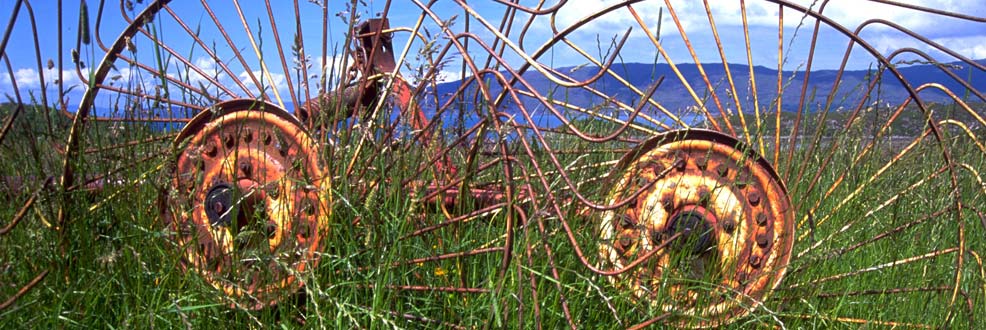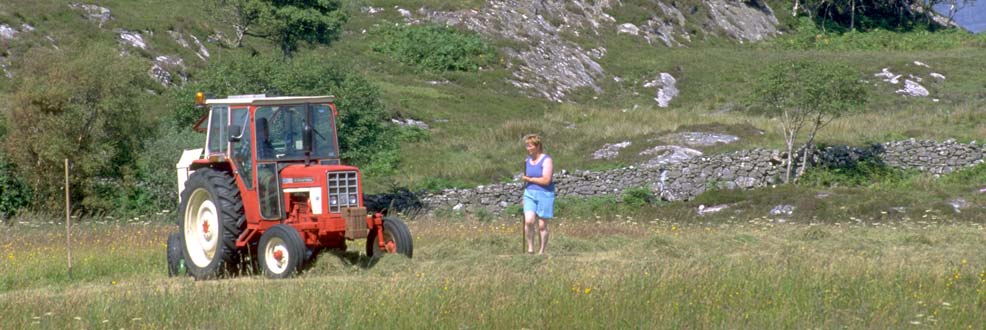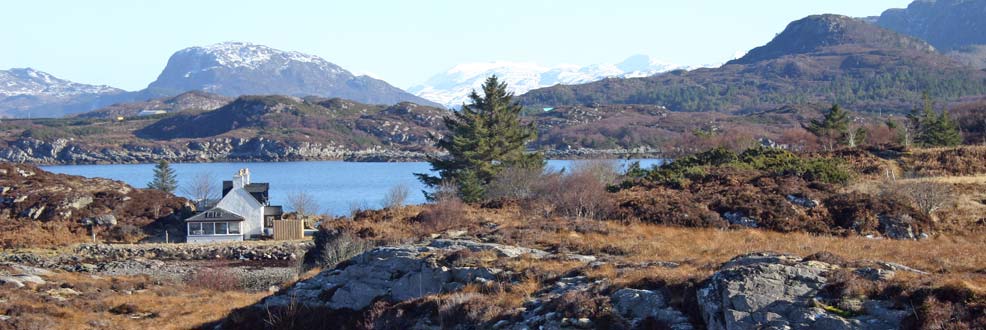Crofter Forestry
HIE Woodland Croft Guidance
‘Lifestyles and livelihoods based on woodlands are traditional in many parts of the world, but are currently rare in Scotland. Woodland crofts are an opportunity for individuals and communities to build lives and livelihoods based on the woodland resource, and the approach to management taken by woodland crofters is expected to deliver increased social, economic and environmental benefits'.
What is a woodland croft?
‘A croft is a unit of land subject to the Crofting Acts. Crofting is a system of land tenure that applies in the crofting counties (and in other parts of Scotland in areas designated by an order made by Ministers). It is regulated and supported by the Crofters Commission.
Traditionally crofting has been based primarily on agriculture, often supplemented by other sources of income. The Crofting Reform Act 2007 however amended existing crofting legislation and introduced some significant changes. These included the ability for new crofts to be created, and also for crofts to be put to a 'purposeful use' other than cultivation.
As a result it is now possible to create crofts from existing woodlands, manage them as woodland and run woodland-related businesses from them.
Although it is anticipated that woodland crofts will always involve an element of woodland management, the exact nature and extent of this is not prescribed. Whilst there are constraints on how a woodland is managed at the whole woodland scale, there is considerable flexibility for individual woodland croft tenants to manage their crofts to meet their own needs and aspirations.
The main mechanism for establishing woodland crofts is expected to be through purchase of woodland from the Forestry Commission by a community body under the National Forest Land Scheme (NFLS), and the subsequent creation of crofts, although other possibilities exist'.
Woodland Crofts Partnership
‘This website aims to encourage, support and advise both existing and prospective woodland crofters. It brings together in one place existing information and guidance on woodland crofts, what they are and how they have come about.’
The following points are addressed:
What is a woodland croft?
The benefits of woodland crofts?
Obtaining a woodland croft
How can my community maximise the public benefits of woodland crofts?
Particularly useful is the section on Guidance, with documents about the following:
Woodland Crofts Allocations – Guidance for Community Landlords
Woodland Crofts Housing and Development
Woodland Crofts Benefits Checklist
Woodland Crofts – Forest Management Guidance
Rural Housing Bodies and Rural Housing Burdens
Woodland Crofts: Enabling Croft Housing - a series of videos from a Woodland Crofts Housing Seminar in Ardfern, Argyll (2010). The first video, of a talk by David Blair from Dunbeag, Argyll, is particularly inspiring and shows how it is possible to both live in and make a living from Scottish woodland.
The Small Woods Trust are a national organisation for woodland owners, workers and supporters. They offer help and advice, training and education, projects and consultancy and encourage sustainable woodland management.
The Forestry Management department at SRUC has consultants who offer a range of specialist services, including:
• Timber sales and felling permissions
• Woodland creation and maintenance
• Hedgerow planting and maintenance
• Grant applications and administration including review inspections of old and problematic grant contracts
• Forest planning and design
• GIS mapping and survey work
• Health and safety and environmental legislation compliance
• Woodfuel advice
• Sales of carbon credits
• Day to day management and supervision of operations
• Small scale civil engineering projects. Design and supervision of work
The Forestry Commission has a page for Grants and regulations. Grants are available for planting trees and managing woodlands. There are regulations that protect the environment and prevent illegal felling. This section has information on grant schemes, legacy grants and regulations:
Review of forestry planting approval procedures - The review aims to reduce the complexity, duration and cost of tree planting applications.
The Forestry Grant Scheme (FGS) supports new woodland creation and sustainable management of existing woodlands. There are eight categories – two for new woodland creation and six for managing existing ones. Within the categories, there are other options relating to specific types of project.
Farm woodlands - if you're interested in creating and managing woodlands, you could get help from the Forestry Grant Scheme to help with costs.
Land leasing - Forestry Commission Scotland gives farmers and landholders the chance to lease land to Forest Enterprise Scotland. They can establish new productive woodland, and hand it back.
Felling licences - if you want to fell trees you may need a felling licence before you start. Information about exemptions and an application form are available on the felling licences pages.
Environmental Impact Assessment - if you want to plant trees, fell without replanting or construct forest roads or quarries, Forest Enterprise Scotland need to check your project's environmental impact. If they think it'll have a large impact, you must apply for permission. They'll give you their formal opinion. Full details are on the Environmental Impact Assessment page.
Public registers
There are three online public registers:
- Register of Grant Schemes – areas and location of applications we receive for creating new woodlands, details of Forest Plan applications and amendments to contracts under the Forestry Grant Scheme
- Register of New Planting and Felling – areas and location of applications we receive for creating new woodlands (includes RDC-RP applications) and for felling trees
- Register of Environmental Impact Assessments – details of the decision we have made when assessing certain forestry projects for their effect on the environment
Native Woodlands
The Native Woodland Survey of Scotland (NWSS) was carried out from 2006-2013 in order to establish the first authoritative picture of Scotland's native woodlands. The report, Scotland's Native Woodlands, was released on 3rd February 2014 by Paul Wheelhouse MSP, the then Minister for Environment and Climate Change. The 100-page document gives a national overview of the NWSS results and assesses the state of Scotland’s native woodlands.
Scotland’s woodlands – SNH give an overview of the main types of ‘native woodland’ in Scotland, from the Caledonian pinewoods in the east, to the oak and birch woods of the west.
Wood Pastures
The Woodland Trust produced a document to emphasise the ecological importance of wood pasture, entitled Wood Pasture, definition, restoration, creation. ‘Wood pasture is classified as a mosaic habitat valued for individual park-like trees particularly veteran and ancient, and the fauna, flora and fungi it supports, including a number of species that only occur in wood pasture and parkland. Grazing animals are fundamental to the habitats existence and many sites are also important historic landscapes. Wood pasture is found in many European countries, though some are without ancient trees. It is a habitat that probably dates back to the original wildwood or to Neolithic livestock keepers.’ This document contains a section about Glen Finglas in the Loch Lomond and Trossachs National Park and describes its history and the current management. ‘The long-term vision for Glen Finglas is to create a dynamic ecosystem of wooded areas and open ground, managed as a wood pasture system. Tree cover and open areas will be allowed to expand and contract over time, in response to natural processes, and as long as the overall value of the habitat is maintained.’
SNH also produced a comprehensive document called 'Wood Pasture', written by Roland Stiven and Kate Hall. The authors make the point that following the purchase of Glen Finglas by the Woodland Trust in 1997, the interest in upland wood pasture, as opposed to lowland sites in England and Wales, has grown. Methods of regeneration and restoration are discussed together with management strategies.
Shelterbelts
The Forestry Commission document, ‘The Principles of using Woods for Shelter’ gives a technical explanation about how trees can be used to afford shelter, particularly for agricultural purposes. Given that wind exposure is a serious factor in many crofting areas, planting trees for shelterbelts could have significant benefits for crofters.
Community Woodlands
‘The Community Woodlands Association was established in 2003 by Scotland’s community woodland groups to help them achieve their aspirations and potential: we provide advice, assistance and information, facilitate networking and training, and represent and promote community woodlands to the wider world.’
Scottish Crofting Enterprise publish a book entitled 'Managing small woodlands in the highlands and islands' which is a guide for crofters, communities and small woodland owners.











